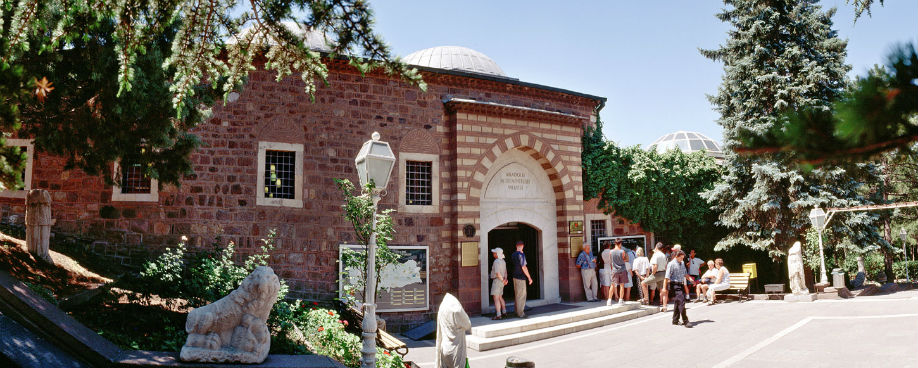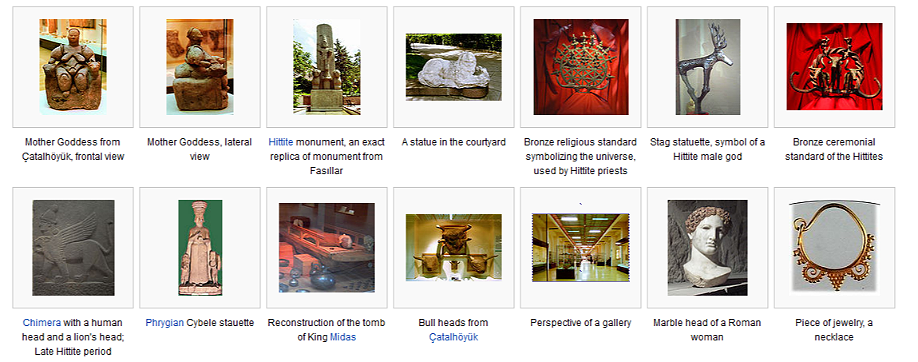The superb Museum of Anatolian Civilisations is the perfect introduction to the complex weave of Turkey’s ancient past, housing artefacts cherry-picked from just about every significant archaeological site in Anatolia.
The museum is housed in a beautifully restored 15th-century bedesten (covered market). The 10-domed central marketplace houses reliefs and statues, while the surrounding hall displays exhibits from the earlier Anatolian civilisations: Palaeolithic, Neolithic, Chalcolithic, Bronze Age, Assyrian, Hittite, Phrygian, Urartian and Lydian. The downstairs sections hold classical Greek and Roman artefacts and a display on Ankara’s history. Get there early to avoid the flood of tour groups and school parties.
The exhibits are chronologically arranged in a spiral: start at the Palaeolithic and Neolithic displays in the room to the right of the entrance, then continue in an anticlockwise direction, visiting the central room last.
Items from one of the most important Neolithic sites in the world Çatalhöyük, southeast of Konya – are displayed here. There’s a mock-up of the inside of a dwelling typical of those uncovered at the site, one of the most famous mother goddess sculptures unearthed from the excavations and wall paintings of hunting scenes.
Also on show are many finds from the Assyrian trading colony Kültepe, one of the world’s oldest and wealthiest bazaars. These include baked-clay tablets found at the site, which dates to the beginning of the 2nd millenium BC.
One of the striking Hittite figures of bulls and stags in the next room used to be the emblem of Ankara. The Hittites were known for their relief work, and some mighty slabs representing the best pieces found in the country, generally from around Hattuşa, are on display in the museum’s central room.
Most of the finds from the Phrygian capital Gordion, including incredible inlaid wooden furniture, are on display in the museum’s last rooms. The exhibits also include limestone blocks with still-indecipherable inscriptions resembling the Greek alphabet, and lion- and ram-head ritual vessels that show the high quality of Phrygian metalwork.
Urartian artifacts are also on display here. Spurred by rich metal deposits, the Urartians were Anatolia’s foremost metalworkers, as the knives, horse-bit, votive plates and shields on display demonstrate. There are also terracotta figures of gods in human form, some revealing their divine powers by growing scorpion tails, and neo-Hittite artefacts.
Downstairs, classical-period finds and regional history displays provide a local picture. Excavations have unearthed a Roman road near the Column of Julian, and Ankara has its own ‘missing link’, the 9.8-million-year-old Ankarapithecus (a 30kg, fruit-eating primate).




Some of the rooms and basement were closed off for renovation but what was available from Paleolithic times to Hittite times was well laid out and interesting. Nice museum but could have been better if more was open based on the little we saw.
For years I have heard of the treasures in this museum and when we got there we discovered that only 2 out of 5 halls were open.
It was a little difficult to get there due to construction but was worth the visit. many exhibits dating from the earliest times. Well explained. The outdoor area is also worth spending time exploring
The only reason I did not rate this as excellent is that most of it was closed for renovations. The exhibits we did see were amazing–and all with English translations. Pages of the anthropology texts come to life!
A stunning collection laid out so well. Just excellent and not to be missed. We went on to Hattusas and visited a smaller museum so interesting to have seen the former.
we have visited many museums and it was so refreshing to see some really unusual exhibits, displayed very well, with very good enghlish written information. The museum is not big so you are interested all the way round. We would definately go back if we were in Ankara again.
We did this as part of our tour. It was really good to see and hear about the early civilisations of the different parts of Turkey.some good artefacts on display
They have an amazing selection of carved stone reliefs dating back to the Hittite times and through the Roman period. The outer courtyard has numerous statues from various time points.
The display cases have important details about the meaning. Unfortunately when we were there the downstairs was under renovation so we missed the Roman exhibits.
Worth a look, hopefully the…
This archeological museum brings you strait in time journey more then to 4000 year back. Nice to see this rich exposition and to touch the ancient monuments – feel the past, pump some adrenalin…. Some parts were closed during our visit.
The number of peoples and cultures that have been part of Anatolia is impressive. This museum has excellent artifacts and art from all of them. The pieces are well displayed and the information provided is helpful.